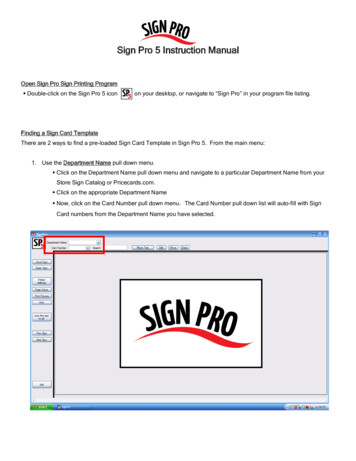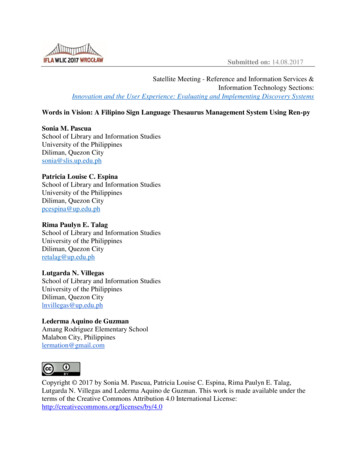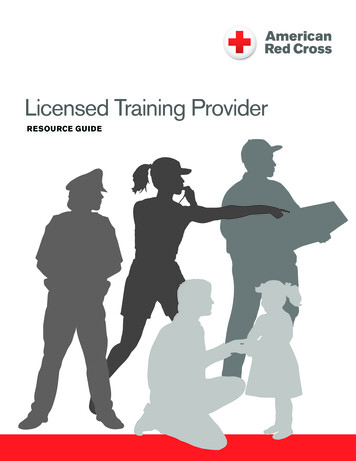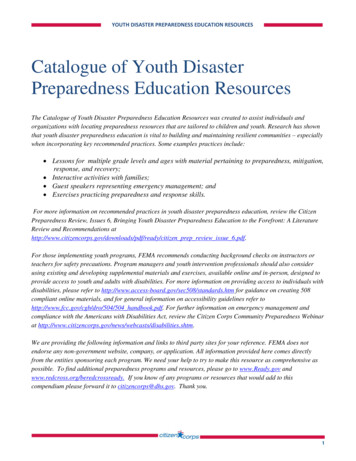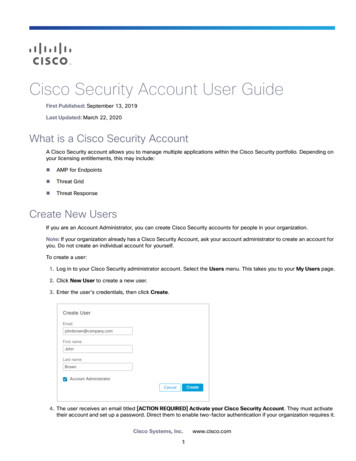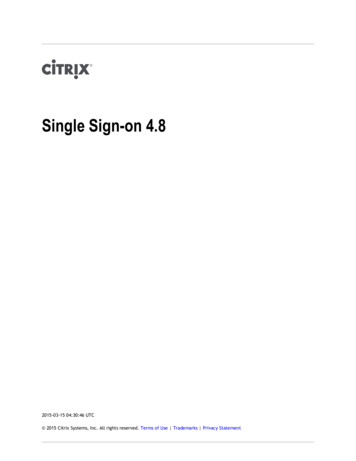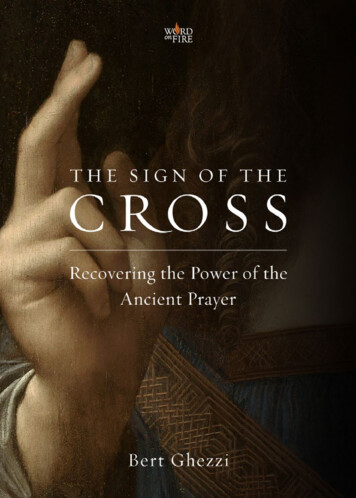
Transcription
THE SIGN OF THECROSSRecovering the Power of theAncient PrayerBert Ghezzi
Word on Fire, Park Ridge, IL 60068 2021 by Word on Fire Catholic MinistriesAll rights reserved.Unless otherwise indicated, all Scripture passages are taken from The New Jerusalem Bible,Doubleday Standard Edition, copyright 1985 and 1999 by Doubleday, a division ofRandom House, Inc., and Darton, Longman & Todd, Ltd. Used by permission.Scripture passages marked RSV are taken from The Revised Standard Version of the Bible,copyright 1946, 1952, 1971, by the Division of Christian Education of the National Councilof Churches of Christ in the U.S.A. Used by permission.Scripture passages marked NRSV are taken from New Revised Standard Version Bible,copyright 1989, by the Division of Christian Education of the National Council of Churchesof Christ in the U.S.A. Used by permission.Scripture passages marked NIV are taken from the Holy Bible, New International Version. Copyright 1973, 1978, 1984 by International Bible Society. Used by permission of ZondervanPublishing House. The “NIV” and “New Inernational Version” trademarks are registered in theUnited States Patent and Trademark Office by International Bible Society.Use of either trademark requires the permission of International Bible Society.www.wordonfire.org
“One of the reasons why Infinite Wisdom has chosen theCross is because a slight motion of the hand is sufficient totrace upon us the instrument of the divine torture: brightand powerful Sign, which teaches us all that we have toknow, and serves as a buckler against our enemies.”1—S T. A LC U I N OF YOR K (7 3 5– 8 0 4 )
CON T EN TSCH A P T ER ONERecovering the Power of the Ancient Sign1C H A P T E R T WOA Short History of the Sign of the Cross11CHAPTER THR EEAn Opening to God19C H A P T E R F OU RA Renewal of Baptism31CHAPTER FIVEA Mark of Discipleship43CH A PTER SI XAn Acceptance of Suffering55CH A P TER SEV ENA Defense Against the Devil65C H A P T E R E IG H TA Victory Over Self-Indulgence75CONCLUSIONGraces and Choices85B I B L I O G R A PH Y91N O T E S93
CHAPTER ONERecovering the Power of the Ancient Sign“But as for me, it is out of the question that I should boast ofanything at all, except of the cross of our Lord Jesus Christ,through whom the world has been crucified to me and I to theworld. . . . After this, let no one trouble me; I carry branded onmy body the marks of Jesus.”— G A L AT I A N S 6 : 1 4 , 1 7“This sign is a powerful protection. It is gratuitous, because ofthe poor. Easy because of the weak. A benefit from God, thestandard of the faithful, the terror of demons.” 1—S T. C Y R I L OF J E RU S A L E M (c . 3 15–3 8 6 )“Adorn and protect each of your members with this victorioussign, and nothing can injure you.” 2—S T. E PH R E M T H E S Y R I A N ( 3 0 6 –3 7 3)1
Aleksandr Solzhenitsyn leaned on his shovel andwatched the gray clouds that dragged sullenlyacross the sky. A merciless wind tore at himthrough his prison garb. He felt as though it penetrated tohis soul. Every bone and muscle ached. Hunger gnawed hisstomach. Years of hard labor in the Siberian work camp hadruined his health and stripped him of hope.Solzhenitsyn could endure no longer. He dropped hisshovel, left the work gang, and sat on a bench nearby. Soona guard would command him to return to work. When hewould ignore the order, the guard would beat him to death,probably with his own shovel. He had seen it happen toothers many times. A quick, bloody death today, thoughtSolzhenitsyn, would be better than a slow death in a bleakand empty future.He stared at the ground, waiting for the inevitable.Soon he heard footsteps and braced himself in anticipationof the guard’s harsh words. But when he raised his eyes,instead of a guard, he saw a gaunt, elderly prisoner standingbefore him. The old man said nothing, but knelt in front ofSolzhenitsyn. With a stick he scratched the sign of the crossin the dirt and hurried back to work.3
Solzhenitsyn looked at the cross and, as he reflectedon it, a ray of light penetrated his dark thoughts. In thatmoment, his perspective changed radically. He realized thathe did not have to face the evil of the gulag and the Sovietson his own diminished strength. With the power of thecross, he could withstand the evil of not just one but of athousand Soviet empires.He got up from the bench and returned to work.Externally, none of Solzhenitsyn’s oppressive circumstanceschanged that day, but internally he had experienced a gentlerevolution. The sign of the cross had blessed him with thegrace of hope.3I found this story in an internet search, and it movedme deeply because it affirmed something I had been discovering in my own prayer. For some reason, in the pastfew years, I have taken the sign of the cross more seriously.I signed myself more frequently and with more reverenceand faith. Over time I sensed that crossing myself tappedinto a powerful divine energy that had many practical consequences for my life. It opened me to a flow of graces thatstrengthened me to face the challenges that arose every day.When I reflected on how things were going for me, Irealized that I was doing better with controlling my angerand overcoming other problems. I also felt that I was relating to God more freely and directly. I asked myself what Iwas doing differently that might account for this noticeableprogress. The only answer I came up with was my prayingmore earnestly with the sign of the cross.As I sought to understand what was happening to me,I read some articles and books about the sign of the cross. A4
little research showed me that what was a novel experiencefor me had been the normal, everyday experience of Christians in the Church’s first centuries. I learned that manyearly Christian writers described how believers signed themselves frequently. For example, Tertullian (c. 160–c. 240),a theologian writing at the turn of the third century, said,“In all our travels and movements, in all our coming in andgoing out, in putting on our shoes, at the bath, at the table,in lighting our candles, in lying down, in sitting down,whatever employment occupies us, we mark our foreheadswith the sign of the cross.”4 And my reading showed further that the Fathers of the Church testified to the greatblessings and power attached to the sign of the cross. I willquote them extensively throughout this book, but here Iwill cite only St. John Chrysostom (347–407), the eloquentfourth-century preacher and patriarch of Constantinople:Never leave your house without making the sign of thecross. It will be to you a staff, a weapon, an impregnablefortress. Neither man nor demon will dare to attackyou, seeing you covered with such powerful armor.Let this sign teach you that you are a soldier, ready tocombat against the demons, and ready to fight for thecrown of justice. Are you ignorant of what the cross hasdone? It has vanquished death, destroyed sin, emptiedhell, dethroned Satan, and restored the universe. Wouldyou then doubt its power? 5When I was a little boy, my mother taught me to make thesign of the cross as I knelt for prayers at bedtime. For all theyears since, I have signed myself at the start and close of my5
prayer. But in retrospect I realize that, while I have alwaysused the gesture respectfully, I made it routinely, superficially, and unaware of its significance. My recent experienceand my research have changed my view and my practice.To my great benefit, I have discovered and recovered thetremendous power of this most ancient Christian prayer.Sometimes as I sign myself, I imagine that I havetraveled back through time to Calvary. With Mary, MaryMagdalen, and John, I stand at the foot of the cross as awitness to the Lord’s supreme sacrifice. I watch him die ahorrific death out of love for me. Then a soldier pierces hisside and a flood of graces flow from his heart, engulfing mein unimaginable blessings. With this book I encourage youto join me at his cross. Come with me to Golgotha whereyou also will discover the life-transforming power of theholy gesture and open yourself more fully to its wonderfulgraces.I invite you to explore with me the multidimensionalrealities of the sign of the cross. If you accept—and I hopeyou do, for I know you will not regret it—we will discusstogether the following six truths that will enhance yourexperience of the ancient prayer. The sign of the cross is: an act of faith that brings us into God’s presencea way to renew our Baptisman affirmation of our decision to follow Christa decision to accept our share in Christ’s sufferinga defense against the devila means to overcome our faults and to grow inlikeness to Christ6
When Jim Manney, my friend and editor, heard me speakabout these truths, he said that the sign of the cross summedup the entire Christian life and that he wanted me to writea book about it. I agreed with his assertion and his request.I wrote this book to present this most ancient Christianprayer gesture as a simple and reliable way for us to renewour Christian lives.A Fount of BlessingMy enthusiasm for the sign of the cross, multiplied by theenthusiasm of the early writers whom I cite, may lead you toa false conclusion about how it works. Let’s be clear up frontthat the gesture does not cause blessing or empowerment.Rather, the sign of the cross opens us to God’s blessing andpower. Distinguishing sacramentals from sacraments willhelp us get this right.The Church calls the sign of the cross a sacramentalbecause it operates like a sacrament. But a sacramentaldiffers significantly from a sacrament. A sacrament is a signor symbol that causes what it signifies. For example, in Baptism, God uses water, a symbol of cleansing, to wash awayall of our sins. A sacramental does not confer divine gracesthe same way a sacrament does, but rather it prepares us toreceive God’s blessing and disposes us to cooperate with it.When we make the sign of the cross, for example, we openourselves to the Lord’s doing something in us. We are preparing ourselves for his blessing and expressing our desire toreceive and use it. A sacrament causes; a sacramental invites.Every time we make the sign of the cross, we invite theLord to bless us, and he always responds. We may sense7
his action as Solzhenitsyn did when he recovered hope. Butmost often when we sign ourselves, we don’t feel anything.That’s because God is using the movements of our bodyto reach our spirit, and our senses cannot register much ofwhat he does there. Yet each time we make the sign, theLord gives us a new burst of divine energy. When we touchour forehead, breast, and shoulders in his name, he touchesour spirit with the blessings of the cross.The Church uses the word grace to describe the blessingbestowed on us through the sacraments and sacramentals.Grace refers to an outpouring of the Holy Spirit that comesto us as God’s free gift. Sanctifying grace is the presenceof the Spirit that saves us and makes us holy. Actual gracerefers to a specific gift of divine energy that supports ourChristian life. Solzhenitsyn, for example, abided in thesanctifying grace that flooded him at his Baptism, and thedivine intervention that gave him hope to endure the gulagwas an actual grace.Like all sacramentals, the sign of the cross disposes usto make better use of sanctifying grace and calls on God togive us actual graces. The Catechism of the Catholic Churchemphasizes this reality:For well-disposed members of the faithful, the liturgy ofthe sacraments and sacramentals sanctifies almost everyevent of their lives with the divine grace which flowsfrom the Paschal mystery of the Passion, Death, andResurrection of Christ. From this source all sacramentsand sacramentals draw their power. There is scarcely8
any proper use of things which cannot be thus directedtoward the sanctification of men and the praise of God.6Here the Catechism adopts and recommends the ancientChristian practice of consecrating daily life with sacramentals, the chief of which is the sign of the cross. Invokingthe blessing of the sign at key moments elevates ordinaryactivities into opportunities for drawing nearer to God—activities such as waking up, eating, driving the childrento school, starting your workday, responding to your email,shopping, relaxing with your family, and going to bed.Blessing others and objects with the sign of the cross isalso an ancient Christian practice. We make the sign in theair over a person or thing while invoking the name of theFather, Son, and the Holy Spirit. The Church extensivelyemploys this form of the sign of the cross as a blessing inthe liturgy. During Mass, for example, the celebrant makesthe sign over the bread and wine to prepare them for thesacrifice, and at the end of Mass, he signs a blessing overthe people to strengthen them for their service of God andothers. Outside the liturgy, priests bless religious objects likerosaries, medals, scapulars, or small crucifixes.I find it difficult to apply the recommendations of manyspiritual books. They overwhelm me with recipes of seven,twelve, or 144 things that I must do to achieve spiritualsuccess, or with complex programs of spiritual disciplinesthat require more effort than I can muster. While I admirethe wisdom of such books, I rarely am able to do what theysuggest. You may feel the same way. But the advice I amgiving in this little book requires only the effort of making9
a simple gesture and praying a simple prayer. Christ didthe hard work when he endured his excruciating Passionand death and made his cross a fount of blessing for us.You can start right now to enjoy more fully the blessingsand power of this ancient sign. Just trace it on your bodywith reverence and faith. Go ahead, do it—even if you arereading this in a public place.Before we consider together the six truths that willbroaden your understanding and experience of the sign ofthe cross, I want to tell you how Christians have made it inthe past, and how we have come to make the large and littlesigns that we make today. But if you are not curious aboutthe history of the ancient prayer, you may skip to Chapter 3and plunge into the core message of this book.10
CHAPTER TWOA Short History of the Sign of the Cross“Go . . . all through Jerusalem and mark a cross on the foreheadsof all who grieve and lament over the loathsome practices in it.”—E Z E K I E L 9 : 4“And then ye bless you with the sygne of the holy crosse . . . Andin thys blessinge ye beginne with youre hande from the heddedownward, and then to the lefte side and after to the right side,in token and byleve that Our Lord Jesu Christe came downfrom the head, that is from the Father into the erthe by his holyIncarnation, and from the erthe into the left side, that is hell, byhis bitter Passion, and from thence unto his Father’s ryghte sideby his glorious Ascension.” 1— M Y R OU R E OF OU R L A DY E (f i f t e e nt h c e nt u r y)“As soon as you get out of bed in the morning, you should blessyourself with the sign of the holy cross and say: ‘May the will ofGod, the Father, the Son and the Holy Spirit be done! Amen.’” 2—M A R T I N LU T H E R , Th e S m a l l C a t e c h i s m11
During the Reformation of the sixteenth century,some Christians repudiated the sign of the crossbecause they judged it to be superstitious. ButMartin Luther himself did not abandon it and recommended the practice in his Small Catechism in an appendixon family prayer. Today, athletes who sign themselves forgood luck at sporting events reinforce the opinion that it isa superstition. But basketball players at the foul line werenot the first to abuse the gesture by ascribing to it magicalpowers that could be turned to dubious personal advantage.As early as the sixth century, St. Caesarius (470–543), thebishop of Arles and one of Christianity’s first best-sellingauthors, rebuked Christians who signed themselves whileon their way to steal or commit adultery.3But no trace of superstition or magic marred the signof the cross in its origins. While no direct evidence exists, itseems clear from circumstances that the holy gesture had itsroots as a prayer in apostolic times. Fourth-century Fatherof the Church St. Basil (329–379) said that the Apostles“taught us to mark with the sign of the cross those whoput their hope in the Lord” 4 —that is, those who presentedthemselves for Baptism.13
So early Christians probably learned to make the signof the cross at their Baptism when the celebrant markedthem with it to claim them for Christ. There is some evidence for this in Scripture. For example, St. Paul remindedthe Ephesians that they received the sign at Baptism whenhe said: “You have been stamped with the seal of the HolySpirit of the Promise” (1 Cor. 1:13). And Paul may havebeen speaking of his being signed with the cross at Baptismwhen he told the Galatians that “I carry branded on mybody the marks of Jesus” (Gal. 6:17). I will say more aboutthis later, but for now I merely want to show you that thesign of the cross originated among people who were not farremoved from Christ himself.Early Christians used the thumb or index finger totrace a little cross on their foreheads. They associated thepractice with references in Ezekiel 9:7 and Revelation 7:3,9:4, and 14:1, all of which describe believers bearing God’sseal on their foreheads. That mark was a cross—the Greekletter tau—that was written as a T and stood for the nameof God. Origen (c. 185–c. 253), a third-century theologianand spiritual writer, commented on the Ezekiel passage byquoting a writer who said:The shape of the letter tau presented a resemblanceto the figure of the cross and that this representeda prophecy of the sign that Christians make on theirforeheads. For all the faithful make this sign when theyundertake any activity, especially prayer or reading HolyScripture.514
So by the third century, Christians frequently markedtheir foreheads with the cross. They also traced the littlesign on their lips and breasts, as we still do today when theGospel is announced at Mass. And they made the sign inthe air as a blessing over persons and things. Tertullian, forexample, told of a woman who signed her bed,6 and St. Cyrilof Jerusalem described Christians tracing the cross “over thebread we eat and the cups we drink.” 7 Using the sign of thecross as a blessing may have prompted some Christians tomake the larger sign that we know today, but that practicedid not come into common use until later on.Opposition to the Monophysite heresy in the seventhand eight centuries may have contributed to popularizingthe larger sign. To summarily refute these heretics, whoheld that Christ had only one divine nature instead oftwo natures, one human and one divine, Christians in theEast began to sign themselves with two fingers or with thethumb and forefinger. They had to trace a larger sign overtheir breasts so that their use of two fingers to defend thetruth would be visible to all. Imagine the duel that occurredwhen a Christian encountered a Monophysite. The Christian would conspicuously make a large sign with two fingersand hurry to the other side of the street. The Monophysitewould respond with a large sign made with his index fingerand walk off in a huff. The idea of that scene may make ussmile, but in those days ordinary folks’ tempers flared overtheological issues.By the ninth century, Christians in the East weremaking the larger gesture with thumb and two fingers displayed, symbolizing the Trinity, and with the ring and little15
finger folded back, symbolizing Christ’s two natures. In themiddle of the ninth century, at a time when emperors hada lot to say about ecclesiastical matters, Leo IV decreed thatall blessings should be made with a large right cross—thatis, with the horizontal gesture moving from right to left.Although this proclamation applied to blessings, it waspopularly adapted to the gesture of signing oneself. Theemperor’s directive established the large sign as the commonpractice in the East. Christians of the Eastern Churchessigned themselves with two fingers and thumb extended,touching their forehead and moving to their breast, thencrossing their shoulders from right to left.How Western Christians came to adopt the larger signof the cross is less clear. Apparently after the ninth centurysome Western Christians imitated the practice of the Eastern Church and signed themselves with a large right cross.But at the same time others in the West had begun to tracethe large cross over their breasts moving their hand from theleft shoulder to the right shoulder.Innocent III (1160–1216), who was pope at the beginning of the thirteenth century, directed that Christianssign themselves with two fingers and thumb extended. Heallowed that some make a right cross and others a left cross,indicating no preference for either approach. But beforethe end of the Middle Ages, Western Christians showed apreference for signing themselves with a large left cross. Forexample, the Myroure of Our Ladye, a late-fifteenth-centurydocument, taught the Brigittine Sisters of Syon Abbey inMiddlesex, England, to cross themselves from left to right.It explained that the movement from forehead to breast16
meant that Christ came down from heaven to earth inhis Incarnation, and the movement from the left to rightshoulder indicated that Christ at his death descended intohell and then ascended to heaven to sit at the Father’s righthand.By the end of the Middle Ages, probably under theextensive influence of Benedictine monasteries, where thepractice was to make a large left cross with an open hand,most Western Christians were making the sign of the crossas we do today.In every age Christians commonly, but not indispensably, accompanied the act of making the sign with words ofprayer. But the prayers varied greatly. In the earlier period,they used invocations like “The sign of Christ,” “The seal ofthe living God,” and “In the name of Jesus.” In later ages,they prayed, “In the name of Jesus of Nazareth,” “In thename of the Holy Trinity,” and “In the name of the Father,and of the Son, and of the Holy Spirit,” the latter being themost common prayer that we use today. Christians havealso used formulas suggested by the liturgy, like “O Godcome to my assistance” and “Our help is in the name ofthe Lord.” 8 This diversity of words accompanying the signshould encourage you to pray spontaneously when you crossyourself, a practice that I recommend in later chapters.Twenty-first-century Christians have inherited a diversity of ways to make the sign. Today you will see peoplemarking themselves with large left crosses or large rightcrosses, with open hand or with two fingers and thumbextended; tracing little crosses on their foreheads, lips, andbreasts with one finger, two fingers, or with thumb and17
forefinger. You may see an Hispanic youth make a largeleft cross and then kiss a little cross made with thumb andforefinger, a practice rooted in the ancient past. You willsee clergy in liturgical settings and laypeople in ordinarysituations blessing persons and objects with two fingers anda thumb or an open hand. But no matter how they do it,large or small, with one finger, two, three, or an open hand,all who sign themselves with faith are opening themselves tothe Lord. We will begin to examine the ways that this signopens us to God in the next chapter.18
CHAPTER THREEAn Opening to God“Whatever you say or do, let it be in the name of the Lord Jesus, inthanksgiving to God the Father through him.”— C OL O S S I A N S 3 : 1 7“Whatever you ask in my name I will do, so that the Father maybe glorified in the Son. If you ask me anything in my name, Iwill do it.”—J OH N 1 4 : 1 3 –1 4“When you sign yourself, think of all the mysteries contained inthe cross. It is not enough to form it with the finger. You mustfirst make it with faith and good will. . . . When you mark yourbreast, your eyes, and all your members with the sign of the cross,offer yourself as a victim pleasing to God.” 1—S T. J OH N C H RY S O S T OM19
If you decide to recover the benefits of the ancient Christian practice, you will sign yourself as frequently as theearly Christians did. You will discover, as I promised inChapter 1, that the sign releases a flow of blessings in yourlife. That’s because the sign of the cross and the words wepray when making it open us to God. Here’s how.Sometimes we sign ourselves silently, opening to itsblessing without saying any accompanying words. Forexample, I quietly mark myself when I board an airplaneor walk through a busy intersection. But while making thesign, we often say, “In the name of the Father, and of theSon, and of the Holy Spirit. Amen.” We call upon the Lordin this way especially when we begin or end our prayers.That’s how the Christian community begins its celebrationof our greatest prayer, the Mass. And the Mass always endswith the priest’s cruciform blessing of the assembly.Making the sign with the invocation of the Trinityrenews our spiritual energy in several ways. It gives us anopportunity to: profess our faith pray to God as he is (not as we imagine him to be)21
enter into his presence pray with “Godpower” (as opposed to mere“humanpower”)Consider these realities with me. Reflecting on them willchange the way you make the sign of the cross. And signingyour self more thoughtfully will open you more fully to Godand strengthen your relationship with him. Few spiritualdisciplines offer so much benefit for so little effort as thisancient and holy gesture.Professing Our FaithThe prayer that we say while making the sign derives fromJesus’ command, reported in Matthew 28:19, that theChurch should baptize new disciples “in the name of theFather and of the Son and of the Holy Spirit.” This formulaevolved into longer creeds by which converts declared theirfaith at Baptism. By the end of the fourth century, newlybaptized Christians in the churches of the East professedthe Nicene Creed, which we now recite at Sunday Mass.Converts in Western churches confessed the Apostles’Creed, which an ancient legend claims that the Twelvecollaborated to compose. The text of that familiar prayerreads as follows:I believe in God,the Father almighty,creator of heaven and earth.And in Jesus Christ, his only Son, our Lord,who was conceived by the Holy Spirit,22
born of the Virgin Mary,suffered under Pontius Pilate,was crucified, died, and was buried;he descended into hell;On the third day he rose again from the dead;he ascended into heavenand is seated at the right hand of God the Fatheralmighty;from there he will come to judge the living andthe dead.I believe in the Holy Spirit,the holy catholic Church,the communion of saints,the forgiveness of sins,the resurrection of the body,and life everlasting. Amen.2Each time we make the sign of the cross, we renewour profession of faith in these truths in an abbreviatedbut spiritually dense form. We express our belief in, andcommitment to, the Father, Son, and Holy Spirit, and weacknowledge their work of creation, salvation, and sanctification.In the past, many Christians believed that even withoutour pronouncing the words, the gesture itself confessed ourfaith. They held that making the sign affirmed essentialChristian doctrines: Touching our forehead and descendingto our breast declared that we believe the Father sent hisSon from heaven to earth to assume our human nature.Touching the left shoulder confessed that the Son died on23
the cross to bring us salvation. And moving to the rightshoulder professed our faith in his Ascension to heaven andhis sending of the Holy Spirit to sanctify us.The sign of the cross holds us to these Christian realities. It assures our loyalty to God and our fidelity to basicChristian doctrines, and so contributes significantly to ourspiritual well-being. We should do it deliberately and often.Addressing God as He IsRelying too heavily on our own idea of God may weakenor distort our relationship with him. But invoking theTrinity when we sign ourselves helps us avoid this unhappycondition. Here’s how our imagination may cloud ourrelationship with God and how the sign of the cross keepsit clear.Recently an interviewer on a national radio programasked listeners what they did when they prayed. Onewoman said she imagined God as being “very, very big”and herself as “very, very small” as she stood before him.Another person said he just “climbed up onto God’s lap andsat there with him.” Using our imagination like this canenhance our prayer, but it may also inhibit our coming toknow God better and love him more.In a worst-case scenario, too much imagining may evencause us to be worshiping our own idea of God instead ofGod himself. In C.S. Lewis’ classic The Screwtape Letters,Screwtape, a senior devil who is training his nephewWormwood to seduce souls, advises him to encourage24
his “patient” to pray to the mental picture of God (whomScrewtape calls the “Enemy”) that he has constructed forhimself. The humans, says Screwtape,do not start from that direct perception of Himwhich we, unhappily, cannot avoid. . . . If you lookinto your patient’s mind when he is praying, you willnot find that. If you examine the object to which heis attending, you will find that it is a composite objectcontaining many quite ridiculous ingredients. Therewill be images derived from pictures of the Enemy asHe appeared during the discreditable episode knownas the Incarnation: there will be vaguer—perhaps quitesavage and puerile—images associated with the othertwo Persons. . . . But whatever the nature of the composite object, you must keep him praying to it—to thething that he has made, not to the Person who has madehim. . . . For if he ever comes to make the distinction,if ever he consciously directs his prayers “Not to whatI think thou art but to what thou knowest thyself tobe,” our situation is, for the moment desper
Scripture passages marked NRSV are taken from New Revised Standard Version Bible, copyright 1989, by the Division of Christian Education of the National Council of Churches of Christ in the U.S.A. Used by permission. Scripture passages marked NIV are taken from the Holy Bible,
